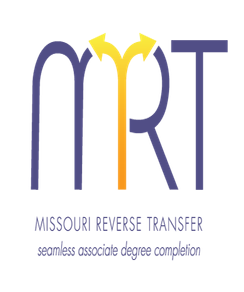Missouri says, 'Definitely!'
Missouri began its reverse transfer initiative in Fall 2012, joining the 11 other states participating in Credit When It’s Due. The Missouri Reverse Transfer Initiative (MRTI) statewide steering committee was selected and given its charge to respond to MO HB1042 that required the Missouri Coordinating Board for Higher Education (CBHE) to develop a policy to foster reverse transfer.
Missouri has 14 public two-year institutions and 13 public four-year institutions that were required to participate in Missouri Reverse Transfer (MRT). Additionally, 15 independent institutions signed on to participate in MRT. Missouri is a local-control state making reverse transfer quite a challenge to coordinate among so many institutions. The timeline for a statewide launch was fall 2014, so we spent the 2013-2014 academic year writing policy, vetting technology, crafting a comprehensive implementation manual, and piloting reverse transfer with 6 universities and 5 community colleges.
Missouri decided that launching a one-year pilot program was the best and only way to prepare for the fall 2014 statewide rollout. The main goals of the pilot program were: 1) to check proof of concept with a limited targeted student population; and 2) to gauge the ease of process for student participation. The pilot institutions were charged with following the steps in the implementation manual to determine the accuracy of the proposed process, compile student responses to the program, and track student progress and success. We needed to know which process steps worked, which ones didn’t, and how we could improve the process. The two-year and four-year pilot Reverse Transfer Coordinators exchanged and shared feedback during the early months of the pilot so we could prepare training for the non-pilot institutions in late spring 2014.
What were the overall results of the pilot program?
We had proof of concept with:
1) 1,263 eligible students were identified and invited to participate in reverse transfer.
2) 98 students opted-in to reverse transfer (8% of eligible).
3) 51 students graduated with associate’s degrees in May 2014 (51% of opt-ins).
What were the lessons learned from the pilot program?
1) The process worked and technically it was sound.
2) The process was very easy for students!! Check the MRT video featuring students at this link!
3) The institutions wanted some additional standardization for processes going forward (e.g., how often and when to send transcripts, how often and when to contact students).
4) Support is needed from across campuses in a variety of functions and at a number of levels.
5) The processes should be automated as much as possible.
6) This is a dynamic process not a static one.
Missouri institutions were better prepared to launch reverse transfer across the state this fall semester due in large part to our learning during the pilot phase.
We want to thank the Lumina and Kresge Foundations for their support of the “Show Me State” and its efforts to make reverse transfer a real opportunity for the 700,000 Missourians who have earned college credit but no degree.
Melissa Hattman is the Director of Community College Relations at the University of Missouri – St. Louis and a member of the Missouri Reverse Transfer Initiative Steering Committee.
